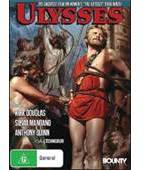Ulysses (1954) (NTSC) |
|
Ulysses (1954) (NTSC) |
|


|
| BUY IT |
| General | Extras | ||
| Category | Adventure | None | |
| Rating |

|
||
| Year Of Production | 1954 | ||
| Running Time | 101:21 (Case: 104) | ||
| RSDL / Flipper | No/No | Cast & Crew | |
| Start Up | Programme | ||
| Region Coding | 1,2,4,5,6 | Directed By | Mario Camerini |
|
Studio
Distributor |
Bounty Films | Starring |
Kirk Douglas Silvana Mangano Anthony Quinn Rossana Podesta Jacques Dumesnil Sylvie Ferruccio Stagni |
| Case | Amaray-Opaque | ||
| RPI | ? | Music | Alessandro Cicognini |
| Video (NTSC) | Audio | ||
| Pan & Scan/Full Frame | Full Frame | English Dolby Digital 2.0 mono (192Kb/s) | |
| Widescreen Aspect Ratio | None | ||
| 16x9 Enhancement | No | ||
| Video Format | 480i (NTSC) | ||
| Original Aspect Ratio | 1.66:1 | Miscellaneous | |
| Jacket Pictures | No | ||
| Subtitles | None | Smoking | No |
| Annoying Product Placement | No | ||
| Action In or After Credits | No | ||
The spaghetti westerns which exploded from Italian companies and directors in the 1960 were not the first genre that the Italians revamped and re-exported to international audiences. Starting in the late 1950s there was a genre of Biblical or quasi-historical/mythical films drawing on Greek and Roman legends that were made and financed in Italy but with an attached international “star”, for example Steve Reeves in Hercules (1958). This genre was the “sword and sandal” films but before the genre as such was recognised there were films of a similar ilk: one was the 1954 Technicolor epic Ulysses, produced by Dino De Laurentiis and Carlo Ponti and starring the one and only Kirk Douglas.
It has been almost two decades since Ulysses (Kirk Douglas) departed for the Trojan War, leaving his wife Penelope (Silvana Mangano) and infant son Telemachus behind in Ithaca. In Ulysses’ absence Telemachus (Franco Interlenghi) has grown almost to manhood while Ulysses’ house has been overrun by a mass of suitors, including Antinous (Anthony Quinn), who seek to marry Penelope and who meanwhile freeload, eat and drink in the house. Penelope, not knowing if Ulysses is alive, under intense pressure and only supported by her son and old retainers Mentor (Ferruccio Stagni) and Eurycleia (Sylvie), has finally agreed to marry the suitor who wins an athletic contest at the next moon.
The scene changes; a half drowned Ulysses is washed ashore on a beach where he is found by Nausicca (Rossana Podesta), the daughter of King Alicinous (Jacques Dumesnil). Ulysses has lost his memory; he does not know who he is, where he is from or where he has been. But Nausicca is smitten and with her father’s permission she intends to marry Ulysses, despite knowing nothing about him. The day before the wedding, however, Ulysses starts to remember what happened to himself and his men while returning home after the sack of Troy.
Ulysses had angered Neptune by desecrating Neptune’s temple at Troy. On their journey home god has put obstacles in the Greeks’ path; Ulysses and his crew had been trapped by the Cyclops Polyphemus (Umberto Silvestri) in his cave, only escaping after they got the Cyclops drunk and blinded his one eye, endured the singing of the Sirens luring them onto the rocks by placing beeswax in their ears while Ulysses was tired to the mast, and finally been seduced and bewitched by Circe (Silvana Mangano again). With his memory restored and Nausicca disappointed, Ulysses in disguise returns to his house in Ithaca where he is recognised by his old dog, greets his son, kills the suitors in battle and is reunited with Penelope.
Ulysses, of course, is based on the lengthy epic poem The Odyssey by Homer, of necessity substantially abridged and with a changed chronology by no less than seven credited screenwriters. It is still, however, an epic adventure with glorious Technicolor, decent special effects for their day and an interesting cast. The big draw is watching a young, bronzed and muscled Kirk Douglas who went on to become a Hollywood icon, superstar and leading man, delving into the ancient world again, for example, in Spartacus (1960). Another future star in Anthony Quinn gets a prominent billing but he appears in only a few scenes and does not have a lot to do; he had far more to do the same year as the lead in Attila (1954), another film produced by Dino De Laurentiis. Silvana Mangano is beautiful but rather stilted; at the time she was married to producer De Laurentiis which may explain the casting. Rossana Podesta is also beautiful but has little impact; she was more prominent a couple of years later as Helen in the Robert Wise directed Helen of Troy (1956).
Also interesting was the talent off screen. Ulysses was shot by cinematographer Harold Rosson whose career spanned three decades and 154 credits on the IMDb including The Wizard of Oz (1939), Singing in the Rain (1952) and, his last film, the Howard Hawks western El Dorado (1967); some of Ulysses was shot around the islands of the Mediterranean and looks beautiful. The rousing score for Ulysses is by Alessandro Cicognini, who himself had 117 IMDb credits on his resume, including a couple of important films for director Vittoria De Sica, Bicycle Thieves (1948) and Umberto D. (1952). Also of note is the fact that Ulysses was partially directed (uncredited) by Mario Bava, the painter and cinematographer who went on later in this career to direct such classic Italian horror films as Black Sunday (1960) and Blood and Black Lace (1964).
Kirk Douglas, Anthony Quinn, a witch, sirens luring sailors to their death, a pre-Ray Harryhausen Cyclops, swords and sandals; Ulysses may now be a bit old fashioned but it is still a colourful and enjoyable adventure; they don’t make like this anymore!
The IMDb gives the original aspect ratio for Ulysses as 1.66:1. For this DVD the opening titles are in this ratio but the film itself is 1.33:1 and not 16x9 enhanced. It is also in the NTSC format. I should note that this is the same for all other available DVD releases of Ulysses.
This is an unrestored print of a Technicolor film that is now over 60 years old. There are numerous small artefacts and some larger splotches of colour, mostly red and blue, some vertical scratches and a couple of frames that shudder. The colours are faded and a bit dull, although there are sections of deep colours such as the sea at night or Kirk Douglas’s bronzed torso. Some scenes are a bit hazy, including the shadow detail and the blacks inside the Cyclop’s cave but close-ups of Douglas’s face and ginger beard are sharp. Contrast and brightness also varied on occasion. However, nothing was too distracting or spoiled the enjoyment of the film.
No subtitles are provided.
| Sharpness | |
| Shadow Detail | |
| Colour | |
| Grain/Pixelization | |
| Film-To-Video Artefacts | |
| Film Artefacts | |
| Overall |
Audio is English Dolby Digital 2.0 mono at 192 Kbps. The film was shown theatrically with a mono audio track.
Dialogue is clear and understandable. The effects were predictably flat but acceptable. There were some pops and clicks and obviously no surround or subwoofer use.
The original music by the prolific Alessandro Cicognini was suitably rousing.
The thing many viewers remember about the sword and sandal films is the atrocious dubbing, and this is in full view with Ulysses. The film was made with both Italian and English audio; Kirk Douglas and Anthony Quinn dubbed themselves in the English version (which is what is on this DVD) but most others were speaking Italian on set so that the lip synchronisation of the dubbing into English is very approximate indeed. But it would not be a sword and sandal film otherwise, so this does not spoil the viewing experience.
| Dialogue | |
| Audio Sync | |
| Clicks/Pops/Dropouts | |
| Surround Channel Use | |
| Subwoofer | |
| Overall |
No extras – the film starts on loading the disc. You can select a menu using the remote, but the only option is “Play Film”.
NOTE: To view non-R4 releases, your equipment needs to be multi-zone compatible and usually also NTSC compatible.
The Region 1 US version of Ulysses includes English and Spanish subtitles but otherwise looks to be exactly the same as this Australian Region All NTSC release.
Ulysses is a colourful old fashioned adventure with witches, magic, a Cyclops, storms at sea, a long suffering wife, obnoxious suitors and a bronzed, handsome hero. There are also swords and a few sandals. What’s not to like! The film is rated G so the violence is very low key, although I suspect that these days it would get a PG at least.
The unrestored Technicolor print could use some work but is still very watchable, the audio is the original mono and the dubbing is a hoot! No extras.
| Video | |
| Audio | |
| Extras | |
| Plot | |
| Overall |
| Review Equipment | |
| DVD | Sony BDP-S580, using HDMI output |
| Display | LG 55inch HD LCD. This display device has not been calibrated. This display device is 16x9 capable. This display device has a maximum native resolution of 1080p. |
| Audio Decoder | NAD T737. This audio decoder/receiver has not been calibrated. |
| Amplification | NAD T737 |
| Speakers | Studio Acoustics 5.1 |